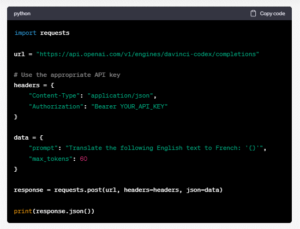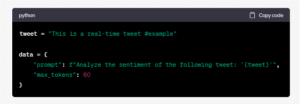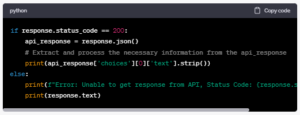Crypto Wallet App Development: Features,...
April 14, 2025

With the rise of artificial intelligence and machine learning, OpenAI’s GPT, a groundbreaking Language Learning Model (LLM), has become a pivotal resource for developers and data scientists to leverage natural language processing capabilities in various applications.
One such powerful application is the ChatGPT API, which can be seamlessly integrated into Python to analyze and interpret real-time data, thus providing versatile solutions for businesses and individual developers.
This API enables users to incorporate conversational agents into their software, allowing for advanced interactions and capabilities. In this article, we will delve into how to utilize the ChatGPT API within a Python environment to empower your applications and projects, especially focusing on real-time data processing and interaction. We will explore the essential steps, considerations, and best practices for integrating this innovative LLM app, ensuring a comprehensive understanding of its functionality and potential.
The ChatGPT API is like a tool from OpenAI that lets programmers talk to the ChatGPT model using computer code. It helps them use OpenAI’s smart language skills in different apps or programs. Developers can use this tool to make ChatGPT create responses that sound like a human, based on what is asked. This can be useful for making chatbots, writing code, creating content, etc. Using the API, developers can change settings like how creative the responses are and how long they can be. To use this tool, developers need a special access key, and they have to follow OpenAI’s rules and prices.
Example
For instance, if ChatGPT is deployed in a healthcare setting, having access to a custom knowledge base filled with medical terminologies, guidelines, and protocols can help in providing more accurate, reliable, and compliant responses to medical queries, enhancing the utility and reliability of the system in such specialized environments.
To integrate ChatGPT with custom data using the LLM (Latent Language Model) app, you essentially need to prepare, search, and ask. Here’s a restated version of your process:
Data Collection:
Utilize the app to pull data in real-time from diverse sources like CSV, JsonLines, SQL databases, Kafka, Redpanda, Debezium, etc., leveraging Pathway for streaming mode.
You can also ingest data in static mode for testing purposes.
Transform each row of data into a structured document schema to handle vast datasets efficiently.
Data Preprocessing:
Engage in elementary data cleansing by eliminating duplicates, irrelevant elements, and noisy data to enhance the quality of responses.
Extract necessary data fields for subsequent processing, ensuring the omission of sensitive or private information to preserve user privacy.
Data Embedding:
Embed each document using the OpenAI API to obtain the resultant embedded data.
Index Construction:
Develop an index on the derived embeddings instantaneously.
User Query Processing:
With a user question from an API-compatible interface, produce an embedding for the query utilizing the OpenAI API.
Retrieve the indexed vectors that are most relevant to the query in real-time, based on the embeddings.
Interaction with ChatGPT:
Integrate the posed question and the pertinent sections extracted into a message directed to GPT.
Procure the response from GPT via the chat completion endpoint and present it as the answer.
To interact with the ChatGPT API using Python, you generally make HTTP POST requests to the relevant API endpoint. Below is a general process that you can follow to use the ChatGPT API with Python Development for real-time data.

Here is a sample Python script that makes a POST request to the OpenAI API.

Replace ‘YOUR_API_KEY’ with your actual API key, and make sure to replace the url and data[‘prompt’] with the appropriate endpoint and prompt for your use case. You can customize the data dictionary with the required parameters such as temperature, max_tokens, etc., according to the OpenAI API documentation.
To use real-time data, you can modify the data[‘prompt’] with the real-time data you want to process. For example, if you are processing real-time tweets, you could have something like this:

Once you receive the response from the API, you can parse it to extract the necessary information and process it according to your needs.

Always remember to read OpenAI’s use case policy, pricing details, and rate limits to understand the constraints and limitations of the API. Also, keep your API keys confidential, and never expose them in your code, especially if it’s public. Utilize environment variables or secure vaults to manage your API keys securely.
Using ChatGPT API with Python is a really useful way to help your business talk and interact with customers quickly and in real-time. This kind of AI Chatbot Development can really change things for your business. It can make conversing with clients simple and programmed, and it assists you with understanding what your customers need by looking at real-time data. This implies you can pursue great business choices in view of what your clients need. Utilizing tools like the ChatGPT Programming interface can assist your business with remaining cutthroat and address your clients’ issues, prompting business development and better client assistance.